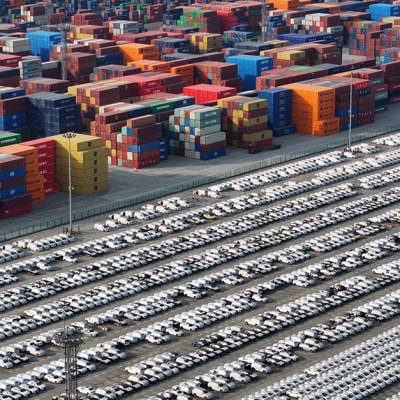Macro and Market review
Volatility returned with a vengeance in April across assets as the US administration's Liberation Day tariff announcements sent markets reeling. The whipsaw in policy announcements that followed saw huge market moves in both directions as uncertainty rocketed and trade-related headlines drove sentiment. Despite the early April shock, policy walk-backs and a softening tone from the US government saw spreads recover from the wides, leaving total returns for the month flat in both US IG and HY and moderately positive in EUR corporates and treasuries, supported by the Euro duration component. Sector performance was clearly a function of tariff exposure, with import-heavy US sectors such as basic industry and consumer retailers hit hardest.The breadth and magnitude of the tariffs implemented on 2 April cannot be understated, taking national tariff levels to century-highs and threatening to completely upend the fabric of global trade. Of equal concern was confusion around the way in which the tariffs had been calculated. The new tariffs were headlined as being 'reciprocal' but in reality showed little relation with actual tariff levels currently levied on the US, making it hard to decipher how progress could be made on any potential reductions. The uncertainty generated by the economic upheaval sent risk assets spiralling, with the S&P falling 10% in just two sessions, taking the total sell-off into bear-market territory. Credit markets were somewhat better behaved but still saw US and EUR HY spreads widening by 120 bps and 110 bps, respectively - to the highest levels in two years.The initial reaction in rates markets was in line with that of a growth shock, as cuts were priced in and term premia shrank, with yields falling across the curve. However, this reversed and actually pushed yields higher as concerns shifted to a potential mass reduction in US asset holdings from abroad. The mixture of risk assets falling, currency depreciating and yields pushing higher is a familiar sight in Emerging Market economies facing balance sheet crises and mass capital flight, but not in the world's biggest economy and reserve currency. Ultimately, it was a sharp move higher in yields in Asian hours on 9 April that threatened financial stability and coincided with a U-turn from the Trump administration. A single social media post saw tariffs reduced universally to 10% for an initial three-month period, from the exceptionally high levels presented a week earlier. This resulted in a huge reversal in risk asset flows, with US stocks posting their largest intraday gains in decades.The one exception to the tariff reduction was China. As the only nation to retaliate to the Liberation Day announcements, levies there eventually rose to 145%, effectively halting all trade between the nations. These levels are not sustainable, as has been highlighted even by US government officials, but remain in place as of writing. The longer these levies remain, the worse the economic scarring will be. That said, the U-turn was sufficient to stem the market rout and ease volatility, setting the base for risk assets to recover through the remainder of the month. Further key support came from a softening in trade rhetoric, showing more appetite for bilateral deals. Another risk was removed as Trump confirmed that he wouldn't look to fire Fed Chair Powell despite sharp criticism of his unwillingness to cut interest rates. Concerns around Powell's potential removal had been haunting risk assets and long-end treasuries for some time. While the news flow from US policy and its impact on sentiment drove markets for the month, fundamental data did produce some interesting points. US growth for Q1 came in lower than expected at -0.3% QoQ, the first negative quarter since 2022, driven by a sharp increase in imports ahead of tariff implementation. Labour market data remained robust though, affirming the Fed's stance that further rate cuts aren't needed imminently, particularly with the inflationary impact of tariffs a looming unknown. The ECB, on the other hand, with fewer pressing inflation issues to hold it back, continued to respond to soft growth with a further cut, but also highlighted uncertainty around trade-induced growth/price impacts moving forward. Clearly, the ramifications of April's vast policy shifts will take time to filter through to hard data and corporate fundamentals, but the ultimate outcome of the debacle is likely to be a sizable growth hit to the US and globally, with a heightened stagflation risk in the former as tariff price increases are passed through to consumers. That said, the impact at a corporate level is likely to affect margins more than creditworthiness, and hence may well be more impactful for equities than credit in the short to medium term. Nevertheless, the environment calls for caution, but the sharp reversal seen mid-month on policy shifts can highlight the risk of reducing risk at inopportune moments in such markets. Remaining invested but defensive in credit remains our view, particularly now, with spreads at more elevated levels. We still prefer duration, as we envisage central banks prioritising growth and labour markets if conditions worsen, with inflation shocks likely to be more short-term in such a scenario.
Portfolio Activity
There were three new Fallen Angels in April, all of which were a little unusual.GFL Environmental is a Canadian waste management services company that has an issuer rating of Ba2 S/BB S. It has six bond issues outstanding - four unsecured, rated Ba3/BB-, and two secured. The secured bond issues were upgraded to investment-grade Baa3/BBB- in March. However, one of the issues included language indicating that the security was released (and not replaced) if it achieved an investment-grade rating; when this occurred, the issue became unsecured and was therefore downgraded to Ba3/BB-, in line with the other unsecured issues. The other new entrants came from the property sector: German real estate company Aroundtown and its residential real estate subsidiary Grand City. Aroundtown's senior rating was cut by one notch at S&P to BBB with a stable outlook, which meant the corporate hybrids were cut from BBB- to BB+ and entered the Fallen Angel universe. The rationale for the downgrade was clear as Aroundtown's financial metrics had remained above that required for the BBB+ rating since 2023 and were not expected to improve sufficiently in 2025. Grand City's rating simply follows that of Aroundtown, although, viewed on a stand-alone basis would, we believe, support a BBB+ rating. We were a little surprised by the rating action as Aroundtown's metrics have improved steadily and are only slightly outside S&P's requirements, especially as it has successfully weathered the challenges facing real estate issues since interest rates started to rise in 2022, but ultimately, S&P's patience has been exhausted. We have already been invested in the hybrid bonds for some time as the market had driven prices to incredibly low levels; they have recovered now but still offer value.
Performance
The Fallen Angel strategy is a high-quality high-yield strategy with an average rating of BB.The Fund performed in line with the Fallen Angel index in April but under-performed the high-yield index, driven primarily by the relatively high index weight to discretionary retailers and consumer goods companies that may be heavily impacted by tariffs, such as Kohl's, Newel Rubbermaid and VF Corp as well as APTV in the automotive sector. The Fund remains modestly ahead of both the high-yield and Fallen Angel index before fees year to date, driven by a positive sector allocation across Basic Industry and Banks and a positive contribution from Walgreen Boots and Auchan, although this was partially offset by weakness in certain names perceived as exposed to the negative impact of tariffs in the retail (Kohl's, Newel Rubbermaid) and automotive (APTV, Nissan, ZFF) space.
Outlook
Trump tariffs are dominating markets at present. While there is no immediate increase in Fallen Angels supply, the impacts of tariffs is a clear credit negative which suggests there is potential for further supply in due course. We will also look to take advantage of any price dislocations in tariff exposed sectors where we feel the price action has been too extreme.









